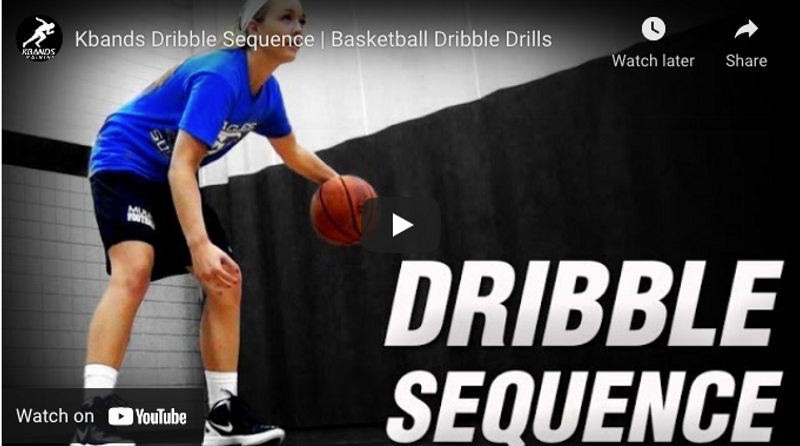Kbands Dribble Sequence: Basketball Dribble Drill
No matter how fast basketball players can move during a breakaway sprint, or how well they can anticipate plays, execute jump shots, or maintain a powerful offense, no team can fully control the court until they can master basic ball handling skills. Whatever challenges a game situation may present, a player who can hold onto the ball during a quick maneuver will have the advantage.
Ball handling skills are partially linked to strength—the hand, wrist, arm, back, and core are all engaged while a dribbling motion is underway. But the most important aspect of ball control starts in the mind. To maintain possession, nothing helps more than powerful hand-eye coordination, and nothing develops hand-eye coordination better than repetition and practice.
Basketball dribbling drills should play a role in every practice session, and players who hope to gain real skill in this area need to dribble a ball for a least a few minutes almost every single day. Since this action doesn’t strain the joints or overextend large muscle groups, almost no amount of practice is too much. But at the same time, focusing on the quality of these practice sessions rather than the quantity will help teams and players make faster improvements. The video below offers a dribble drill practice sequence that helps basketball players control the ball from every angle.
Basketball Dribble Sequence: Setting Up the Drill
This drill requires no equipment except a high quality ball and a hard floor. Coaches should make sure every player has a ball of his or her own, and as players work through this drill, coaches should keep a close eye on posture and technique, offering pointers when necessary so players can fix bad habits before they become ingrained.
Basketball Dribble Sequence: Executing the Drill
This drill involves a sequence of dribbling patterns: the crossover, the side dribble, the crazy eight, and the spider dribble. Here’s a breakdown of each move in the pattern:
1. The Crossover
For this dribble pattern, players will brace the feet slightly wider than shoulder width apart, drop the center of gravity, and begin passing the ball from the left hand to the right, allowing a single bounce between the feet. Players should execute ten to fifteen passes from hand to hand, all the while keeping the arms long, flexible, and powerful. Note how the athlete in the video keeps her eyes up and focused on developing game situations, not fixated on the ball. With enough practice, players will able to maneuver the ball while maintaining divided attention.
2. The Side Dribble
After the crossovers, the player will move the ball onto her right side and execute 10 to 20 dribbles from the front of her body plane to the back. Viewers will notice how her wrist rotates to bring the ball from front to back while keeping the bounce motion under control. After completing the exercise on the right side, the player will execute 10 to 20 more dribbles on the left.
3. Crazy Eights
In the next dribble sequence, the basketball player will widen the stance slightly and begin passing the ball from hand to hand in a figure eight pattern that winds through the feet. For the first 10 reps of this move, the athlete can move the ball around the eight in one direction, bringing it from front to back on the left and back to front on the right. Then she can switch this pattern and reverse the direction of the figure eight in order to work the other side.
Again, during the entire exercise, the athlete should stay aware of the position of the back, shoulders and chest. Posture is critical to strong ball handling skills, and while the chest stays low, the back and shoulders should stay straight and the player should stay alert to changes on the court.
4. The Spider Sequence
In this challenging sequence, the ball will remain in place between the basketball player’s feet, but the athletes arms will move back and forth across the barrier formed by her upper leg. The player touches the ball with the right and left hand from the front, then touches it again with the right hand and then the left from behind her back. When executed properly, the ball never undergoes more than one bounce between touches, so the hand and arm motions have to be fast and the player has to develop a strong sense of rhythm.
As with the other stages of this dribbling drill, the basketball player should complete a full set of four touches (one for each hand, both back and front) about 10 to 20 times total. This entire sequence can be completed once for each specific session, but there’s nothing to lose and plenty to gain by completing the entire round again from the beginning. Once again, when it comes to dribbling and ball handling skills, practice makes perfect.
This drill can be worked into any seasonal or off season training program, and coaches can encourage players to take these moves away with them after the training session is over and practice them at home, in the driveway, in the yard or anywhere else they can find a ball and some space to maneuver.

